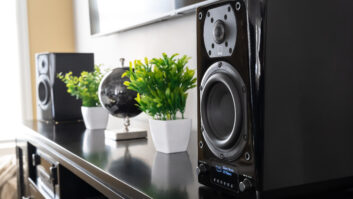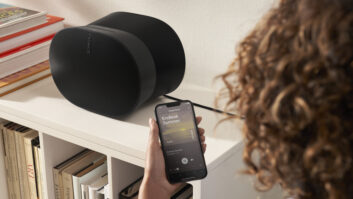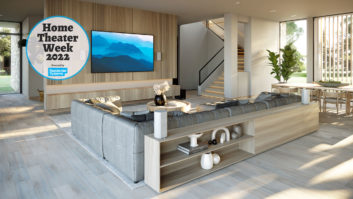It seems to me that the only things popping up with greater frequency these days than funny cat videos on YouTube are new wireless multi-room audio standards. And I guess there’s a good reason for that. People really, really want to play music in every room in the home, with minimal effort and at a reasonable expense. And there are a lot of ways to skin that particular kitty.

The W7 is a gorgeous little six-inch cube with a four-inch mid/bass drier, two side-mounted bass radiators, two “front-firing” 1-inch aluminum dome tweeters, and two “side-firing” 1-inch aluminum dome tweeters. The most talked-about newcomer to the wireless distributed audio game is Play Fi, a Wi-Fi based technology that was originally purchased from Phorus by DTS and since licensed to Polk Audio, Definitive Technology, Wren, MartinLogan, Paradigm/Anthem, Core Brands, and others, each of whom is developing its own line of integrated wireless speakers and integrable players, all of which will be compatible with one another.
Really, the best way to sum up Play-Fi is to contrast it with the other widely available means of wirelessly distributing music, because on the surface it seems designed to address their perceived shortcomings. Unlike Bluetooth, it isn’t compressed and doesn’t suffer from limited range. Unlike Sonos, it isn’t a closed architecture and doesn’t require a proprietary hub. Unlike AirPlay, it isn’t locked up in the Apple ecosystem and is available on a wider variety of mobile devices. And unlike SKAA, it doesn’t rely on a dongle.
We’ll eventually get to the point, I’m sure, where a review of a Play-Fi system ignores the strengths and weaknesses of the format itself, and focuses purely on the hardware. Given that Play-Fi is still relatively new and unfamiliar, we’re not quite there yet. But before we dig into Definitive Technology’s specific implementation of Play-Fi, let’s look at the company’s “Wireless Collection” products in and of themselves.
The lineup is pretty diverse, and fairly indicative of how other companies are approaching Play-Fi. In addition to the W7 and W9 Wireless Speakers (both of which I’m reviewing today), Definitive offers a streaming amp for connecting to speakers of your choosing (the W Amp), a streaming player for integrating with complete sound systems (the W Adapt), and a soundbar system with a wireless subwoofer (W Studio).
Despite sharing a lot of obvious common DNA, the W7 and W9 are actually quite different speakers. The W7 is a gorgeous little six-inch cube with a four-inch mid/bass drier, two sidemounted bass radiators, two “front-firing” 1-inch aluminum dome tweeters, and two “side-firing” 1-inch aluminum dome tweeters. I put air quotes around “front-firing” and “side-firing,” because orientation of the W7 is more of a suggestion than a hard-and-fast rule. It truly is a room-filling wondering of a speaker.
The W9, by contrast, looks at first glance like two W7s stuck side-by-side, but it’s a little larger than that, actually: roughly 7.5 inches high and deep, and about 16.6 inches wide. It sports two 5.25-inch woofers and two 1-inch aluminum dome tweeters in a front-firing configuration, along with two side-firing 2-inch “full-range” drivers.
Both speakers are exactly as well built as you could hope for with wireless speakers in their price range ($399 and $699). They’re exquisitely built, they both feel hefty (but not artificially so), and the quality of their materials is excellent. Both feature optical and auxiliary analog inputs in addition to their Play-Fi connectivity, and both feature wired Ethernet as well as 2.4 GHz and 5.8 GHz Wi-Fi support.
And both sound absolutely fantastic, although each speaker has its relative strengths. I have to admit, I prefer the W7 both for its more neutral sound and its enhanced portability, but it struggles to reach rocking volumes in larger rooms of my home, where the W9 positively shines. The W9 also delivers an appreciable stereo experience from a single cabinet, whereas the W7 is more of a “big, room-filling mono” sort of thing. But on the Android version of the app, at least, you can pair two speakers in stereo mode, a function that isn’t available on iOS at the time of writing.
Which brings us to the app itself. Definitive Technology has its own version of the Play-Fi App, as do Polk and Phorus, and there’s a generic Play-Fi app offered by DTS. They’re all essentially re-skins of the same app, and all work the same. Which is to say that sometimes they work and sometimes they don’t. Setup is incredibly easy: you simply launch the app, minimize it, connect to the speaker via Wi-Fi, launch the app again, and put in your Wi-Fi password. And it’s a good thing that it’s so easy, because I found myself going through the process on a regular basis, since for reasons I can’t quite figure out, the Play-Fi app just occasionally forgets how to Play-Fi.

The W9 looks at first glance like two W7s stuck side-by-side, but it’s a little larger than that, actually: roughly 7.5 inches high and deep, and about 16.6 inches wide. It sports two 5.25-inch woofers and two 1-inch aluminum dome tweeters in a front-firing configuration, along with two side-firing 2-inch “fullrange” drivers. This can’t be blamed on Definitive Technology, by the way, nor the W7 or W9 specifically. Every time I’ve run into this problem, my Net Analyzer app confirmed that both speakers had a rock-solid connection to the network and were fully pingable.
The other problem, from a technology point of view, is that the multiroom implementation of Play- Fi isn’t entirely intuitive. The app designates one speaker in the system as Primary and the others as Secondary. If, during your listening, you decide to turn off the Primary zone, the music stops (although you can turn on and off secondary zones at will). There’s a really good technical reason for this, which has to do with the way Play-Fi handles synchronization (and I can confirm that music across multiple zones is perfectly synched, with virtually zero latency). But in practice, I can see this as becoming infuriating for consumers who don’t know or care how the technology works.
At present, the selection of music available to mobile users is also limited. The app includes support for internet radio, local networked media, Deezer, Pandora, KKBOX, Songza, and of course tunes stored on the portable media device itself. But there’s no way to stream, say, Spotify from a phone for now. That requires the use of the desktop app, which is only available for Windows machines and not OS X. (Definitive Technology notes that Spotify is coming to iOS and Android apps in 2015.)
Definitive Technology has knocked it out of the park with its first Play-Fi family of products. The speakers are gorgeous, they sound fantastic, and they offer integrators a lot of flexibility in getting multi-zone audio into areas where clients may not want to pay for a truly custom solution.
410.363.7148
definitivetech.com
Kudos
Definitive Technology’s W7 and W9 Wireless Speakers are gorgeous, incredibly well-made, and sound truly fantastic.
Concerns
It’s hardly DefTech’s fault, but there’s still some work to be done on the Play-Fi architecture before it’s really ready to take on Sonos or AirPlay.
Product Specs
W9
• Inputs: Optical, Analog, Ethernet, USB-A for firmware updates
• Driver Complement: Two front-firing 5-1/4”woofers; two front-firing 1.0”aluminum dome tweeters; two side-firing 2.0” full-range drivers
W7
• Inputs: Optical, Analog, Ethernet, USB-A for firmware updates
• Driver Complement: One front-firing 4.0” midwoofer; four 1.0” aluminum dome tweeters; two 4.0” bass radiators







